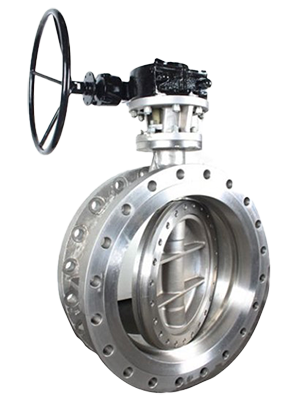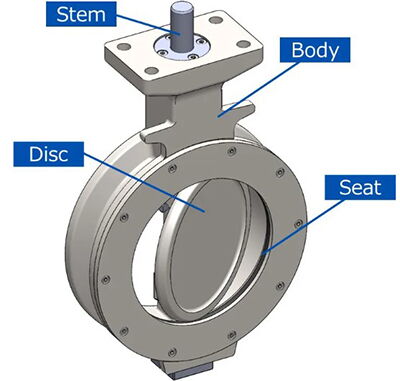Essential Factors for Effective Butterfly Valve Design
On this page
Butterfly valves are widely used in pipeline systems for on/off and flow regulation applications. Their simple structure and ease of operation make them suitable for controlling and shutting off the flow of various media. The design of butterfly valves requires careful consideration of multiple factors, including the characteristics of the medium, process conditions, sealing requirements, flow capacity, and the type of actuator. Below are the key factors to focus on during the design of butterfly valves to ensure their efficient and stable performance across different operating conditions.
The primary functions of butterfly valves are to shut off the medium in the pipeline or to regulate flow. It is important to define the specific application of the valve.
Shut-off Function: If the butterfly valve is intended for turning the medium on or off, emphasis should be placed on the valve's sealing ability and shut-off performance. The valve must provide reliable sealing to prevent leakage. Soft sealing structures are typically used in low, medium pressure, and ambient temperature conditions, while hard sealing structures are preferred in high-temperature and high-pressure environments to handle greater pressure and temperature variations.
Regulation Function: When the valve is used to regulate flow and pressure, attention should be given to its regulation performance and flow control characteristics. The valve's flow characteristic curve must be optimized during design to ensure a good control range at various openings, allowing for stable and precise flow regulation over a wide flow range.

Understanding the conditions of the process system is crucial when designing a butterfly valve. This includes, but is not limited to, the following factors.
Medium Type: The medium may be gas, liquid, solid, or a mixed phase (such as gas-solid or liquid-solid). Different media require different valve design considerations, particularly if the medium contains solid particles or has high viscosity, which can cause significant wear on sealing components and flow passages.
Medium Temperature and Pressure: The temperature and pressure of the medium directly influence the material selection, structural strength, and sealing design of the valve. In high-temperature environments, the materials must have higher heat resistance, and attention must be given to avoiding uneven expansion that could lead to seizing or leakage.
Flow Velocity and Flow Rate: The velocity of the medium affects the valve's flow capacity and the erosion performance of the sealing surfaces. For gas-solid or liquid-solid two-phase flows, higher flow velocities require valves with stronger anti-erosion capabilities.
Power Source and Parameters: The type of actuator driving the butterfly valve—whether electric, pneumatic, or hydraulic—directly impacts the valve's opening and closing performance, response time, and sensitivity. The design must ensure that the actuator performs reliably under varying operational conditions.
Temperature Effects: The temperature of the medium significantly affects the valve's sealing ability, material properties, and overall stability. At higher temperatures, material strength decreases, and thermal expansion may cause uneven deformation of valve components, which can impact opening/closing performance or lead to leaks. The design must take into account the impact of temperature gradients on the sealing components to prevent seizing or leakage due to uneven expansion.
Thermal Expansion and Thermal Shock: In high-temperature environments, thermal expansion may lead to local yielding or deformation of valve components. Therefore, materials with good thermal stability must be selected, and thermal expansion compensation structures should be incorporated into the design.
Pressure Effects: The pressure of the medium influences the strength, stiffness, and sealing pressure requirements of the valve's pressure-bearing components. The design must ensure the valve can withstand the forces at maximum pressure, while the sealing components must provide sufficient clamping force to prevent leakage.
The structural design of the butterfly valve determines its flow capacity and pressure loss. The following factors should be considered.
Pressure Loss and Flow Capacity: Pressure loss measures the resistance to fluid flow through the valve and is typically expressed through the flow resistance coefficient. The flow resistance coefficient is influenced by the valve structure, internal component shape, and surface roughness. To reduce pressure loss, the design should avoid narrowing of the valve body's passage and minimize protrusions within the passage while ensuring smooth transitions for the disc profile.
Flow Capacity: Flow capacity refers to the maximum flow rate allowed by the valve under a given pressure differential. The design should aim to increase the flow area within the valve body, minimizing flow resistance while maintaining smooth surface finishes inside the passage to enhance flow capacity.
Surface Roughness: The roughness of the flow passage surfaces significantly affects the flow resistance. During design, efforts should be made to minimize surface roughness to reduce the erosion of valve components and flow resistance.

The actuator type for a butterfly valve can vary based on application requirements, including electric, pneumatic, hydraulic, or electro-hydraulic drive. The choice of actuator will impact the valve's response speed, opening/closing time, regulation precision, and overall reliability.
Actuator Torque: The torque required by the actuator is influenced by factors such as the valve's sealing capability, structure, medium type, pressure, and operating frequency. The design must ensure that the actuator provides sufficient torque for opening and closing the valve.
Actuator Sensitivity and Reliability: For regulating butterfly valves, the actuator must have high sensitivity to ensure precise flow control. Additionally, the actuator's reliability is critical, especially in applications where frequent valve operation or extreme conditions are involved.
The design of the sealing components is crucial for the long-term stability of butterfly valves, particularly in harsh conditions such as dust-laden, corrosive, or high-temperature/high-pressure environments. Key factors include:
Sealing Material Selection: For butterfly valves used in applications involving solid particles, sealing rings are typically made from elastic rubber materials. For high-temperature or corrosive media, metal seals or multi-layer metal hard seals can be used to enhance corrosion resistance.
Self-Cleaning Structure: In dusty or highly contaminated environments, butterfly valves may incorporate self-cleaning sealing components. This design allows the sealing surfaces to automatically remove particulate matter through relative motion, reducing the impact on sealing performance.
The primary failure mode of butterfly valves is leakage, which can occur as either external or internal leakage:
External Leakage: This is usually caused by corrosion or wear of the valve body material, typically resulting in damage to the valve body or seat.
Internal Leakage: This is caused by damage or failure of the sealing components, allowing the medium to leak through the valve seal.
The lifespan of a butterfly valve depends on various factors, such as medium type, temperature, pressure, and frequency of operation. The design should involve selecting appropriate materials and necessary heat treatment processes to improve resistance to abrasion, corrosion, and fatigue, ensuring a long service life.
The complexity and diversity of butterfly valve design require engineers to consider each design aspect carefully. From analyzing process system requirements to optimizing valve structure, selecting sealing components, and choosing the right actuator, each design decision will directly affect the valve's performance and lifespan. A well-designed butterfly valve will provide stable and efficient flow control and medium shut-off functionality in various operating conditions.

